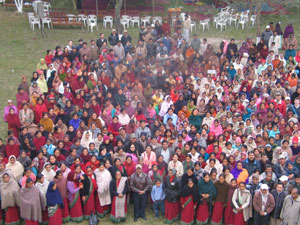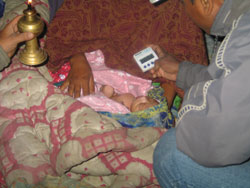Nepal Journal: Reflections on a Trip with Al Sommer (web article)
Roger Lipitz, a member of the Bloomberg School’s Health Advisory Board, and dean emeritus Alfred Sommer, MD, MHS, traveled to Nepal in January to visit the School’s research sites and clinics. Lipitz recorded his impressions of the trip in a travel journal to share the highlights of his journey.
As we landed at Kathmandu Airport on a particularly clear day, I got my first glimpse of the Himalayas. We immediately went to the offices of the Nepal Nutritional Intervention Project at Sarlahi and met with faculty from the School and the staff who run the program. In operation for more than 15 years, the project was founded to implement treatments based on Al’s groundbreaking research on vitamin A and its role in reducing child deaths. The program is located near the Indian border. Over the years, the project which has received funding from USAID, NIH and the Bill & Melinda Gates Foundation, has expanded its programs to include research on prenatal care. It has also conducted several studies, including one on the use of vitamin A to reduce early hearing loss by preventing childhood ear infections. The programs are now being replicated in Bangladesh, and Al was headed there after leaving Nepal.

Hundreds of field workers from a
Nepal eye clinic gather at a convention.
Our discussion with the staff focused on the future of the programs when funding runs out. It’s an issue that I am particularly interested in and concerned about. Most of the project’s services are provided by approximately 500 women who live in the area and have been trained to provide vitamin A to children and pregnant woman and umbilical cord care for newborns.
The next day Al and I visited the Tilganga Eye Center, with which Al is associated, and we observed a cataract surgery through closed circuit television. The staff treats tens of thousands of people each year, and also provides care in rural communities. Vitamin A deficits can cause vision loss and other eye problems. With the help of donations, the hospital built a factory to produce lenses for cataract surgery at a fraction of the cost in the U.S. It is an incredibly complicated and labor-intensive process requiring a sterile environment. During our visit, we wore full cover-ups.
The next day we traveled nine hours over mountainous terrain to an eye clinic at the project’s rural headquarters. This second clinic was established at the request of the local population. We saw incredible sights including spectacular views of the Himalayas and the Nepalese countryside. We also stopped at many military checkpoints along the way. A few years ago the King basically suspended the constitutional monarchy and assumed full power. Rebel groups have formed and are fighting to regain power by force. I never felt unsafe but the U.S. State Department has placed Nepal on a list of unsafe countries, so there are few tourists. The eye clinic sees thousands of patients each year, and a doctor from another region makes weekly visits to perform cataract surgeries. We attended a meeting (convention) of clinic employees with at least 400 people in attendance. Most of the workers were women who provide direct care to women and children. The sense of accomplishment and pride in what they are doing was very apparent. After a big meal, there were program awards, speeches, songs and poems performed by the local workers. There is also a sense of sadness because they know the programs are going to be cut back as the funding runs out and what they can accomplish diminishes. As one woman said, “I am happy on the outside but sad in my heart.” I think this may sum up the feelings of the local workers. The program has had a profound effect on many lives. Most research projects don’t last as long, and therefore may not change a community as much as this program has. There needs to be a great deal of thought about what will happen when the program ends. I know it is something people at the Bloomberg School are thinking about a lot.

A field worker visits a mother and
her baby at their home in
a rural Nepal village.
One of the highlights of the trip was accompanying clinic workers on a health visit to a mother and her newborn baby. The family lived in “Seven Brothers,” a village named for its related inhabitants. The house had just one room, a few rugs on the floor, no heat and the fire was in one corner with no ventilation. (School staff have developed a venting system that can be installed for very little money.) We watched as the workers washed and weighed the baby, and took the temperatures of the baby and mother. The baby’s temperature was only 92 degrees, and the workers were concerned about his survival. The technician told the mother to place the baby on her belly to try to warm him. I asked the staff to let me know how the baby did, and after my return home I received an email that he was doing fine and his temperature was normal.
I apologize for the rambling nature of these recollections, but I wanted to get everything in writing while it was fresh in my mind. I hope you enjoyed reading this and got a sense of the special experience it was for me. —Roger Lipitz
